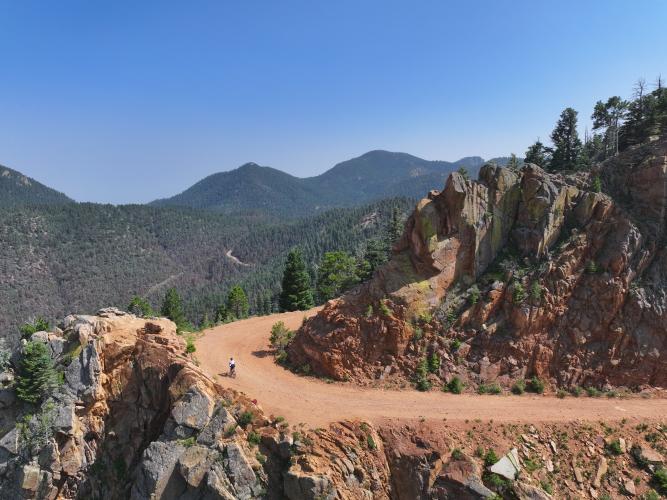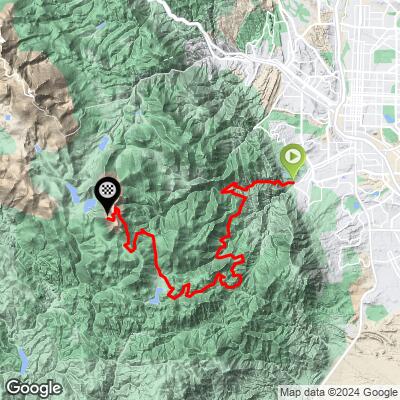![]()
Cycling Almagre, Colorado
Ride 25 miles gaining 6,115’ to 12,266’ at 4.6% average grade (5.1% climb only)
This is the hardest gravel climb in Colorado and the eighth hardest in the United States. Amagre Mountain, also known as Mount Baldy, is the second highest peak visible from Colorado Springs after Pikes Peak.
Climb summary by PJAMM’s Brad Butterfield:
The start point of this climb is on a paved road close to the heart of Colorado Springs. Within a mile you’ll enter North Cheyenne canon Park where the road was laid at the center of a deep rocky canyon. After about 4 miles of paved climbing through the canyon, there is a gate prohibiting vehicle traffic from continuing on the dirt road. At this point, the road is loose gravel and sandy in sections. With a gravel bike/narrow tires, it can be very difficult to keep traction on parts of this section of the climb - but it is doable. A few miles into the gravel road, a gate blocks one of the tunnels this road goes through. Fortunately, there is a hiking trail that skirts around the mountain and rejoins the road. The hiking trail that you must ride to access the road beyond the tunnel is rideable - but just barely. The trail is less than .5 mile long. Beyond the first tunnel, there are two more, which are both open, before the dirt road intersects with national forest road 370. Though this forest road is heavily potholed, it is a marked improvement over the sandy road which takes you to it. A right turn onto FR 379, Frosty Park marks the beginning of the toughest part of the climb. At this point, you’re above 10,000 feet of elevation and the road quality both deteriorates and becomes steep. There are large rocks, deep ruts and potholes, and loose rock to contend with. With a little over one mile left to climb, there is a large gate preventing motorized traffic from continuing to the summit. 2 more large switchbacks bring you to the summit of the mountain, marked by a large raido tower. The final mile to the summit is on very poorly maintained dirt. As the road quality is very poor for much of this climb, it is a very arduous 26 miles to descend on a gravel bike.
![]()
START OF CLIMB TO GRAVEL
The first 3.8 of the 25 miles of this climb are paved and average 6.8% with a gain of 1,314’ to elevation 7,630’ where the the pavement ends and gravel begins at Seven Bridges Trailhead (moderately challenging out and back route - 3.4 miles, 849’ elevation gain).
![]()
The climb begins at the Starsmore Visitor and Nature Center Colorado Springs, by riding west on Cheyenne Boulevard.
![]()
Aerial view west towards Colorado Springs about 3 miles up Cheyenne Canyon Road
![]()
Upper left aerial view west towards Visitor Center; Upper right view east towards Colorado Springs.
Photo from 2 miles up from start.
![]()
The road turnst to North Cheyenne Canyon Road at Starsmore VC and takes you to Helen Hunt Visitor Center
![]()
Parking lot to Helen Hunt VC
The pavement ends at the upper parking lot of North Cheyenne Cañon Park (1,600 acres). The park's origins date back to the late 19th century when General William Jackson Palmer, the founder of Colorado Springs, donated land to establish several parks, including North Cheyenne Cañon Park. In 1885, the City of Colorado Springs purchased an additional 640 acres, making it one of the oldest parks in the city.
![]()
Mile 3.8 - 21.6 miles to go at 4.2% to elevation 12,265’
There is 155’ of descent on the climb, most notably 1.4 miles at -1.45% from mile 15.9 to 17.3
GRAVEL TO TOP
![]()
No off roading sign at mile 4.7 adjacent to the Buckhorn Cutoff Trailhead
![]()
Varying levels of surface on the climb - conditions range from 1 very smooth to 5 very rough.
![]()
NF 370 sign at mile 12.7; NF 379 mile 20.7 and NF 379A at mile 23.
![]()
Mile 11.5
![]()
![]()
Short cave at mile 9
We ride through three short one hundred year old caves used by miners and there are a couple others in view along the climb.
![]()
We encounter a variety of trees along the climb including Douglas-fir, Ponderosa Pine and Colorado Blue Spruce.
Along with the varying roadway surfaces and trees species, we encounter several interesting rock formations along the climb.
![]()
We encounter Gate #1 at mile 11.4 and it is not prohibited to ride around and past it.
![]()
Unnamed Pond at mile 14.8
![]()
County maintenance ends at mile 16.2 and it does get rougher past this point.
![]()
Mile 16.4
![]()
![]()
Sharp hairpin at mile 21.8 - 2.7 miles at 7% and fairly rough riding to go.
Almagre is derived from the Spanish word for red which reflects the mountain and road’s distinctive reddish hue.
![]()
Gate #2 - 1.1 miles at 7.3% to the top.
This is the second, and most formidable of the gates on this climb. The sign says it is for authorized “vehicles” only and goes on to say that the road is “closed to motorized vehicles.” We interpret this to mean that we may ride our bikes past the gate and to the top, which we did. We found nothing on the internet to suggest one cannot hike or ride past the gate and the All Trials Almagre Mountain hike goes past the gate to the peak.
![]()
TOP
![]()
Travel above tree line at about 11,900’ just before the end of the climb.
The photos above are of the last segment of the climb - 1.1 miles at 7.3% gaining 400’ to elevation 12,265’.
![]()
Seemingly abandoned radio towers at the end of the climb.
![]()
Unobstructed views of the surrounding Front Range of the Rocky Mountains from the top.
![]()
That’s a wrap!!

 We've partnered with Sherpa-Map.com to bring you the best route planning tool. With a PRO Membership you can use this climb as a reference when creating your route.
We've partnered with Sherpa-Map.com to bring you the best route planning tool. With a PRO Membership you can use this climb as a reference when creating your route. 

